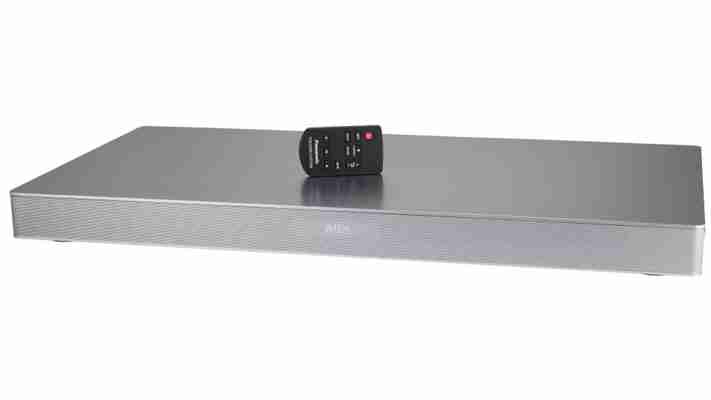January 31,2023
Panasonic SC-HTE180 review
by Jennifer Cameron inMediterranean Style
The Panasonic SC-HTE180 is a little different from your traditional 2.1 sound system, as this speaker board goes underneath your TV rather than in front of it. The subwoofer is also incorporated into the main unit rather than a standalone cabinet, letting you save space while delivering the same audio experience as a sound bar.
It's a similar idea to the Bose Solo, but the SC-HTE180 covers a much wider area, making it more suitable for larger TVs. Measuring 700x365x60mm, we could easily fit our 46in Samsung reference TV on top of the SC-HTE180, but bigger TVs may end up poking over the edge depending on the shape and size of their stand.
The SC-HTE180’s silver metal frame isn’t hugely stylish, but it is discreet. It also has a generous number of ports round the back, including an HDMI input for your Blu-ray player, an ARC-enabled HDMI output to connect to your TV, an optical S/PDIF input, an auxiliary input and a USB service port.
Inside, its 60W speakers and 60W subwoofer are housed behind a fine metal mesh. There are three small buttons on the side for power, volume and input, but you’re better off using the remote when operating the SC-HTE180 from a distance.
We weren’t big fans of the remote, as its minute size not only makes it prone to getting lost down the back of the sofa, but its spongey buttons weren’t easy to use and button presses sometimes took a while to register on the SC-HTE180's display. The volume button was particularly sensitive and often shot up and down in big leaps even though we’d only pressed it lightly.
The remote doesn’t have many buttons either. Aside from the volume control, you can switch input, mute the speaker, change the sound mode and activate Bluetooth, but the rest of the SC-HTE180’s options are relegated to the Setup button, forcing you to peer at the SC-HTE180’s tiny display window on the front of the board and wait for the names of each setting to scroll across the screen.
Here, you’ll find a display dimmer, auto power down, volume limitation, Bluetooth, and Viera Link, which lets you control the speaker board with a Panasonic TV remote. All of these are only on or off options, though, so you can’t set the volume limitation yourself or change the brightness of the display to your own liking.
The Sound Mode button also has several options hidden behind a menu system, including settings for the subwoofer volume, dialogue, H-bass, 3D clear dialogue, dual audio, automatic gain control (AGC) and a low volume mode. You’ll want to leave 3D clear dialogue enabled, as turning it off destroyed the sound quality, but dual audio, AGC and low volume mode made almost no difference regardless of whether we had them turned on or off. H-bass supposedly boosts the subwoofer beyond its four volume level, but again the difference was minimal.
There are also six sound modes to choose from: Standard, Music, Cinema, News, Stereo and Stadium. We liked Music and Standard best, as we thought these produced the most balanced sound combination. Other presets included Cinema, which prioritised bass and made treble sounds appear thin, and the News preset, which reduced treble even further and placed greater emphasis on dialogue.
Sound quality was good, but not particularly outstanding for a £280 system. the Dolby Digital and DTS codecs did a much better job than our TV speakers of recreating the subtleties of Pandora’s jungles in Avatar, and dialogue was clear, even in heated action sequences. However, whenever we skipped a scene the SC-HTE180 took a few seconds to start playing sound again, which meant that we’d often miss important pieces of dialogue. We also noticed a very small amount of delay between the dialogue hitting our ears and the actors forming the words onscreen.
This left us feeling a little disappointed when watching films, but we were happy when we played music via Bluetooth. The SC-HTE180’s sound quality still wasn’t perfect, though, even when we switched to Music mode, as we felt midrange bass were a little overwhelming.
This had the knock on effect of making higher frequencies sound a little thin, and drums, hi-hats and cymbals sounded particularly tinny. Voices occasionally sounded a bit muffled, too, but this varied from track to track. As such, you’ll probably need to spend a fair amount of time adjusting the SC-HTE180’s options to get the best sound, which is more hassle than we’d like for a speaker board at this price.
The Panasonic SC-HTE180 is a decent speaker board with a generous number of ports, but at £280, we were disappointed by its sound quality and fussy menu system. If you don't want to spend more than £300, cheaper soundbars such as the LG NB3540 produce much better audio and are far easier to use.
| Hardware | |
|---|---|
| Speakers | 2.1 |
| RMS power output | 60W |
| Subwoofer option | 60W (included) |
| Rear speaker option | N/A |
| Dimensions | 700x365x60mm |
| Weight | 2.1kg |
| Ports | |
| Audio inputs | 3.5mm stereo, optical S/PDIF |
| Audio outputs | N/A |
| Video inputs | HDMI 1.4 |
| Video outputs | HDMI 1.4 |
| Dock connector | N/A |
| USB port | USB service port |
| Networking | Bluetooth |
| NFC | Yes |
| Features | |
| Video playback formats | N/A |
| Image viewing formats | N/A |
| Audio playback formats | N/A |
| Smart TV apps | N/A |
| Buying information | |
| Price including VAT | £280 |
| Warranty | one year RTB |
| Supplier | www.johnlewis.com |
| Details | www.panasonic.com/uk |
| Part code | SC-HTE180EBS |

